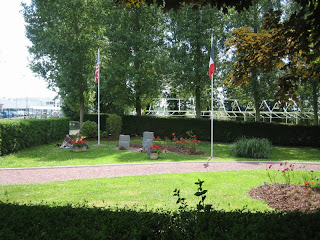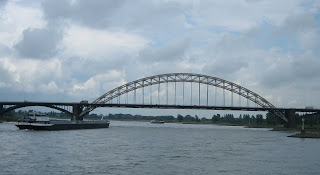Bill, April 1943 - age 17+
I had the privilege of meeting Bill in the spring of 2008, just prior to a family vacation that included Normandy and the D-Day sites. Over dinner, Bill told us stories of his experiences in France and Holland during the war, and in 2008 and 2009 I was able to visit some of the locations he told us about.
Like a lot of young men in 1942, Bill enlisted in the Army - in his case, at the age of 16. He volunteered for the paratroopers, and was trained as a demolitions man.
Bill’s Demolition Section, Nottingham, England, May 1943
Bill was assigned to the Demolitions Section of the Headquarters Company, 508th Parachute Infantry Regiment (known as the Red Devils), which fought as part of the 82nd Airborne Division (The All Americans).
D-Day
Along with thousands of other paratroopers, Bill left England on the night of June 5th, 1944 bound for Normandy aboard a Douglas C-47 like this one:
Douglas C-47, Merville Battery, Normandy
But the aircrews carrying Bill’s regiment, the 508th Parachute Infantry, were inexperienced. They ran into heavy anti-aircraft fire and the planes became scattered, many going much faster than the 125 miles per hour they were supposed to for jumping, and at much higher (or lower) altitudes than the 400 feet called for. The 508th suffered some of the worst scattering of the drop that night; Bill and the other men of his “stick”, or plane-load, landed far away from their designated drop zone.
Bill’s gas mask, strapped to his leg, was shot away by anti-aircraft fire during his descent.
Several men in the stick were missing after the jump and as far as Bill knew, had never been seen again. Their two heavy equipment bags were also lost. The plane had also been going so fast that Bill and the others had actually lost some of the gear strapped to their bodies. This included most of the explosives.
This was a problem because Bill had been assigned to blow up a bridge across the Douve River at Beuzeville-au-Plain, a tiny village along the south edge of the 82nd’s area. The Germans had flooded the countryside - much of which is reclaimed marshland - and it was one of the few ways heavy vehicles could attack across the river from the south. Bill and his fellow soldiers traveled at night, playing hide-and-seek with the Germans who were actively searching for the paratroopers, and finally arrived at their objective on June 9th, D+3, only to find that the Air Corps had destroyed it.
Bridge at Beuzeville-au-Plain, Normandy, July 2008
(Bill couldn’t remember the name of the town when he told us this story, but a bit of research and the phenomenal knowledge of our battlefiled guide, Dale Booth, enabled us to find it.)
Bill’s group then gathered with a larger group of paratroopers under Lt. Colonel Shanley holding Hill 30, a low rise west of the Merderet River. This became a key position protecting the American beachead. They had little cover to protect themselves from German fire, but held until heavier forces could come up from the beaches.
“Hill 30” area near Coquiny, Normandy
He was also involved in some of the fighting near the village of Chef-du-Pont, where still more key bridges were located.
Bridge at Chef-du-Pont, now named for the 508th PIR
Memorial to the paratroopers at Chef-du-Pont,
part of a park funded and maintained by the residents.
part of a park funded and maintained by the residents.
During the fighting in Normandy, one of Bill’s friends, Bill Buchanon of Wyoming, was killed by sniper fire while standing next to Bill.
Bill and the rest of the 82nd fought on in Normandy until they were withdrawn to England on July 13th, 1944.
Holland: Operation Market-Garden
In September 1944, British Field Marshal Montgomery proposed a daring plan - laying a “carpet” of airborne troops across Holland, seizing a series of bridges and holding open a corridor through which Montgomery’s XXX Corps would race to the Rhine and beyond. The 82nd was assigned to the middle section of the corridor, with the US 101st Airborne to their south. To their north, at Arnhem on the Rhine, was the British 1st Airborne and the Polish 1st Parachute Brigade.
The 82nd had to capture a number of bridges, all essential to the operation, but the biggest one was the Waal River bridge at Nijmegen.
Waal Bridge, Nijmegen, June 2009
Nijmegen is only a few miles west of the German border, with a large, wooded ridge - the Grossbeek Heights - between the town and Germany. (The ridge has been a key military position for centuries - remains of an old Roman fort lie atop the ridge.) Bill’s unit, the 508th PIR, was assigned a drop zone between the Heights and the German border, in these lush fields:
Drop zone of the 508 PIR, looking west towards the Grossbeek Heights
Looking south-east from the middle of the 508th’s DZ.
The silver object is a marker and memorial to the 508th.
The silver object is a marker and memorial to the 508th.
Looking east. Germany is less than a mile away, just past the distant treeline.
The Germans counter-attacked fiercely. Bill’s unit was assigned to a position in the town of Beek, which lays at the northern foot of the Heights. Beek sits right along a main road to Nijmegen, and the Germans pushed hard to reinforce their forces holding the Waal bridge. Bill was wounded in the left leg by a mortar fragment in the fighting for Beek.
The fighting in Beek was very heavy, and not many of the buildings from that time remain.
Surviving period buildings in Beek, Holland, June 2009
Like the French, the Dutch continue to honor their liberators.
Memorial to the 508th PIR, Beek, Holland, June 2009
While the 82nd held it’s ground, and was finally able to capture the Waal Bridge on September 20th, XXX Corps wasn’t able to relieve the British 1st Airborne, and two SS Panzer divisions which had been refitting in the area crushed the British paratroopers.
After Market Garden
With Operation Market-Garden a failure, the 82nd continued to hold Holland until it was withdrawn in December - and was then thrown desperately into the Battle of the Bulge, in Belgium. The 82nd was pulled out of the line in late February, 1945.
The 508th was reassigned from the 82nd Airborne Division and attached directly to the First Allied Airborne Army in April, 1945. Bill and the rest of the regiment prepared to jump into POW camps to rescue Allied prisoners, but the mission was never needed.














No comments:
Post a Comment